The Big Neo-Nazi Crib
Have you noticed the shift in image of some neo-Nazis - a shift from the skinhead-look to an anarchist/antifascist image? Whether or not you’ve noticed, you can learn more about this recent strategy of certain factions of the neo-Nazi movement from the following analysis.
Some people say that we live in a time of uncertainty. For those who watch the neo-Nazi movement from a distance it might be hard to tell if a gathering of people dressed in black is a neo-Nazi or antifascist gathering. There are people denying holocaust on some of the demonstrations in the name of freedom and people raising right hand on some of the hiphop shows. A neo-Nazi is no longer just seen as a skinhead in boots holding a beer bottle. The scene that attracts the followers of National Socialist ideology has undergone major changes in the past few years.
Which way does the wind blow?
At the end of World War II, many Nazi criminals were taken to court in an endeavor to wipe Nazism out of German society. Denazification was originally supervised by the U.S., but in 1946, German institutions took over. The Germans decided to draw a thick black line under this chapter in history and set hundreds of thousands of Nazi functionaries free. The estimations from1949 assumed that 30% of government posts were staffed by former Nazis, with only few hundreds of them remaining imprisoned for war crimes. A number of Nazis managed to escape with the help of the underground organization ODESSA, finding shelter in South America or Franquist Spain. New neo-Nazi politics were created by these former nazis, attracting young supporters and influencing the youth.
The pasts of Hitler’s former supporters were also blocked out by the Cold War. Both sides tried to recruit former Nazis. Some ex-Nazis who remained in Germany didn’t change their views to become more “democratic”, but instead, constituted new Nazi political forces and educated new generations of supporters. Otto Ernst Remmer, Hitler’s bodyguard, played an important role in this process by taking the lead in the neo-Nazi political party SRP (Sozialistische Reichspartei Deutschlads), which stood side-by-side with the forming NPD (Nationaldemokratische Partei Deutschlands) in the mid sixties. NPD then took the role of SRP when it was banned. Even the Czech Národní odpor (National Resistance) honors Remmer’s heritage. One of his wards, Michal Kühnen, established the Action Front of National Socialists (Aktionsfront Nationaler Sozialisten/Nationale Aktivisten) in 1977. Kühen brought the violent aspect back to neo-Nazi politics and quite successfully infiltrated skinhead subculture. It is not without piquancy that Kühnen, even after publicly disclosing his homosexuality remained a leading figure of the German neo-Nazi movement until he died of AIDS in 1991. German neo-Nazis gained significant power after the fall of the Berlin wall when attacks on the minorities became more frequent, culminating in the Molotov attack on a lodging-house in Rostock.
When there is a lack of creativity
The connection between neo-Nazis and skinheads was successful for years, but at the end of 90’s, the boundaries became an anachronism and a burden. What previously seemed militarist and tough became ridiculous; a neo-Nazi skinhead wearing a bomber and boots with white laces became a symbol of eness and primitivism. Trying to modernize their image, neo-Nazis gathered inspiration from the anarchist, autonomous and antifascist scenes. The word “inspiration” is rather an euphemism. Neo-Nazis usually steal symbols and methods as they are, without modifying them. That might not be surprising with a single motto or symbol, but Nazis are starting to steal the visual concept and practical methods of the autonomous scene as a whole. Practical ways of self-organization; its ideological content – everything can shamelessly become an armory of the proud nationalist. What is so attractive about this attitude? There are several reasons that Nazis are drawn to this attitude:
- Neo-Nazis suffer from the lack of creative people inside their own movement.
- Neo-Nazis need to put their radical views in a nice and acceptable package.
- For neo-Nazis, it is not the views, political agenda or coherent ideals that are important. They care more about gaining political influence, power and action of any kind – even senseless.
- Neo-Nazis want to confuse the public and make it hard to tell who is on which side of the barricade.
- Neo-Nazis have gotten into a situation where any change is better than none
Founding of Antifascist Action (AFA)
The founding of Antifascist Action dates back to 1923. It originally came into existence as a part of Rotfrontkampferbund, an organization aiming to actively fight Nazis. There were battles for literally every street, pub and factory. The goal was to take every place to gather or recruit new supporters away from the Nazis. Antifascists had already begun using the logo with two flags in a circle. When the Nazis took over the government, antifascists were killed, sent to concentration camps or they started illegal organizations and alliances.

In the 90’s, the principles of AFA expanded abroad. Autonomous antifascist groups realized that clear rules are necessary for any kind of action and became more open to the public. Besides demonstrations and direct actions, they started organizing cultural events, lectures, seminars, exhibitions and concerts. The new motto stated that political work should not depend on personal contacts and affection, but on political goals and ideals. A constant struggle started, which aimed to build a firm structure and gain new supporters for the organization as well as independent individuals and collectives to cooperate with.
Back to the Plagiarizers : The First Big Crib
The influence of Nazis and Fascists in the skinhead subculture can be considered as the first big Nazi crib. The skinhead subculture grew at the end of sixties as a stepchild of the British mod subculture and Jamaican immigrants‘ Rude boys. This subculture consisted of working class youth, both white and black, opposing the mainstream. Ideologically tinged, racist and fascist politics were brought in it later by Ian Stuart Donaldson and his band – Skrewdriver. Stuart openly supported the British National Front, and they, in turn, supported him to gain youth supporters.
Later, a need to stand up to the Nazi theft of the skinhead subculture emerged. In the eighties the SHARP movement (Skinheads Against the Racial Prejudice) and RASH (Red and Anarchist Skinhead) started in the US. Among these movements, groups of traditional apolitical skinheads honoring the classic sixties‘ concept remained.
It is without a doubt that neo-Nazis succeeded in infiltrating the skinhead subculture and making people in many countries perceive „skinhead“ as a synonym for ‚neo-Nazi‘. This successful crib of the skinhead subculture helped the Nazis gain many supporters, although later, it became a limitation leading to a mass turning away from the skinhead subculture. Nevertheless, this crib is a good illustration of the neo-Nazis‘ thief-like practices.
The Situation in the Czech Republic.
In Czechoslovakia, a strong racist movement started to grow in the early nineties, with the band OrlÌk as the leading influence. Orlík managed to attract the undecided youth, those looking for an attractive lifestyle, with their racist lyrics and idealogy. OrlÌk records were sold in mainstream record stores and made it to the top of the charts. The band broke up after two releases and the invention of “Calixtinism”, a theory linking modern fascist tendencies to the Hussite era. This was soon replaced with neo-Nazism – a more attractive phenomenon that is easier to understand.
Czech racists, fascists and neo-Nazis preferred to use as their symbols the Confederate flag, the Celtic cross or the triskele “three sevens” symbol, sometimes in a form of the three-branch svastika (a symbol of Afrikaans Movement of Resistance in South Africa).
During this time, the antifascist and anarchist movements appeared in Czechoslovakia. These groups stuck to their autonomous principles and D.I.Y. politics.
The skinhead image, once so popular among Nazis and feared and respected among the public, later came to be perceived as ridiculous and disgusting. After fifteen years, neo-Nazis found themselves at a crossroads. They could either stick to their skinhead image, or they could turn their backs on it and find something new. Time passed, and none among the nation’s elite had been able to come up with something new. Neo-Nazis had seemingly reached their limits and couldn’t go any further.
Around 2000, National Alliance activists made he first attempts to refresh the neo-Nazi image. Their outfits, consisting of white short-sleeved shirts and Daddy’s tie didn’t last long. Nevertheless, it was resuscitated by National Corporativists and former Nazi skinhead Jiří Petřivalský (currently a Workers‘ Party member) – and it failed again. The National Resistance was a little more successful with their attempt to mix the skinhead image with expensive sports brands.
The Nazi Image Turns
German neo-Nazis faced the same problems in the mid-90s and tried to find a way out from their limited reach. The NPD appeared on the political scene, offering neonazis an official platform (the same as the Workers‘ Party in Czech Republic at the end of 2007), and ways of attracting young people were being sought. Neo-nazis were starting to look to the style of the autonomous antifascists - their political opponents - and to copy it. The first “autonomous nationalist” organizations appeared, and brought a brand new aspect to neo-Nazi street politics. The Plagiarism era had begun, and it still goes on, in spite of the conflict between the skinhead neo-Nazi traditionalists and those who see copying the antifascist image and practices as the way out of the ghetto. Something has changed, though. Most neo-nazi groups in Germany have implemented the concept of autonomous nationalism. The names of these groups vary – Kamaradschaften, Free Nationalists, Autonomous Nationalists - yet they all copy the antifascist and autonomous demonstration tactic (the media-beloved Black Bloc) and they all have changed the structure of the hierarchical groups according to the older neo-Nazi pattern, so-called Leaderless Resistance. The groups are supposed to be leaderless, but “small leaders” emerge from the regional groups, with the rest forming into a mindless mob of followers.
Right behind
In Czech Republic, Filip Vávra was the first pioneer trying to import a new style, but the conservatives in the National Resistance didn’t want to hear about any kind of change. The first organization implementing the new image appeared later, in 2005. Autonomous Nationalists Kladno came into existence in an attempt to organize local Nazis and change their only previous activity – sitting around in bars. They also started to promote their own version of Black Bloc – but for them, it has been more of a new fashion trend than a tactical element. In addition, they’ve tried to get a hold on a variety of new topics, such as ecology, anti-capitalism, resistance against multiculturalism, globalization or animal rights. They partially managed to get into the techno subculture through Filip “DJ Beax” Pošva.
Lets create something ourselves or neo-Nazism as a lifestyle
The new visage was successful at the beginning. As mentioned above, the neo-Nazis were in a situation where any change was for the better. In the previous decade, their self-presentation was in the name of hatred and negation, but now they are starting to present National Socialism as something that can influence everybody’s life here and now – not just after the takeover. Almost everything can be “National-Socialist” - from biking or graffiti to an Asian grocery store boycott. Through this strategy, neo-Nazis offer a lifestyle that contributes to the struggle for the white Europe they dream of so much.
The all-European flagship of the new neo-Nazi lifestyle is the“politically-cultural web project Zentropa, that concentrates on artist reflection of European tradition and European culture”. This web project presents a broad range of information on events such as exhibitions, fashion or concerts. The German affiliate of Zentropa, Syndikat-Z, is managed by Anne-Marie Doberenz, femme fatale to the important German Nazi-activist Steffen Pohl from Duisburg, who she almost got to commit a and who she made to end in mental hospital in autumn of 2008.
Anne-Marie Doberenz at Workers Party (Dělnická Strana) event in Prague in 2008, and an evolution of her image since 2002.
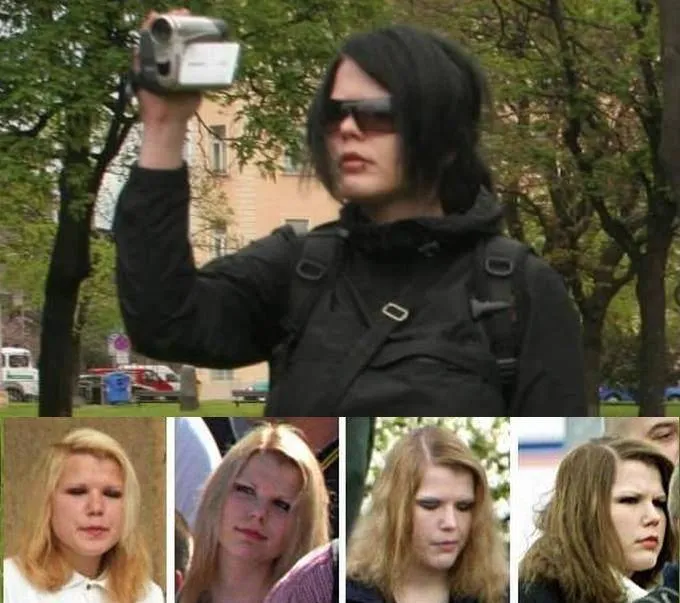
Steffen Pohl, wearing American anti-racist hardcore band Walls of Jericho motif on his sweatshirt at a demonstration in Dortmundt

And here he is wearing a sweatshirt of an American anti-racist band Agnostic front at a Workers Party demonstration in 2008 in Prague, mentioned above, where Pohl made a speech. The person wearing a kefiah on Pohl's left is Tomáš Málek from National Resistance (Národní Odpor), a leader of Workers Party in Brno, the person on Pohl's right is Workers Party leader from Vlašim and National Resistance Vysočina member Jiří Bárta.
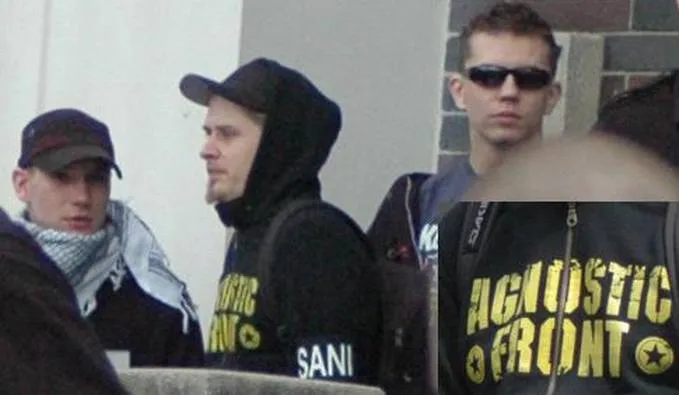
The founder of the National Resistance,
Filip Vávra
, presented one of his many one-man shows trying to promote vegetarianism among neo-Nazis, but his fellow warriors laughed at him. He then tried to get patronage from the Agricultural Animals Protectors‘ (OHZ) chief, who, surprisingly, offered him space on the organization’s website for an antisemitic petition against the killing of kosher and halal animals. Most of the former OHZ supporters turned away from the organization after it co-operated with him. Vávra’s commitment to the vegan lifestyle didn’t last long and after a few failed attempts with the vegan diet, documented by other neo-Nazis, he turned away from it.
Brown political marketing
Besides their surface appearance, neo-Nazis also had to radically change their political agenda when they realized the difficulty of gaining power with an agenda of blood-line nationalism, racism and honoring of the Third Reich. The lack of real political theories and thinkers is characteristic of the neo-Nazi movement and it results in inconsistency of opinion and chaotic moves amongst many theories, including Jewish plot, 19th century social darwinism, opposition of capitalism, glorification of capitalism, refusing Islamic fundamentalism and supporting Islamic fundamentalism. Most fascists and neo-Nazis still rely on historical revisionism, one that concentrates on denying historical facts such as the Holocaust or the causes of World War II.
Traditional neo-Nazism started to fall apart when it started to agree with the apologetic neo-Fascists. The New Right, a movement that started in 1968, has been a major influence on contemporary neo-Nazis and neo-Fascists. The best known member of this movement is Alain de Benoist, who helped to build the nationalist think-tank GRECE (Group for Research and Education of the Civilization of Europe). They don’t take a primitive racist stand, but they criticize and oppose multiculturalism and promote the “crisis of the European identity”. Benoist is known for his disgust for American imperialism and capitalism with his views approaching the authoritarian left, leading to statements like “It is better to wear a Red Army helmet than to live in Brooklyn and eat hamburgers”. The stand he takes towards Le Pen and his fascist National Front is also interesting. He considers the National Front members incapable of understanding the complexity of the world and accuses the group of blind hatred, passivity towards social problems and intellectual laziness.
The new musical-political project, RIF (Rock Identitaire) is rooted in the same ground. It offers a cultural platform for spreading neo-Nazi or neo-Fascist views without mentioning Hitler or Mussolini. Identitaires also conduct projects typical of the anarchist and autonomous scene – information centers and community houses called “Houses of the Identity”. The movement doesn’t use racist theories, but instead it works with the concept of “Identity” as it’s connected to national and cultural being.
The rest of the neo-Nazi opinion vacuum is filled with copies of their opponents’ views. The neo-Nazis in Germany have been trying to infiltrate the Green Party since the eighties and yet have shown shallow interest in ecology - it is obvious that their interest ends with statements and no action. Similar to other topics, ecology is being used to attract supporters rather than to solve problems.
Another topic that is gaining popularity among Nazis is anti-capitalism. However, as with so many other topics, their criticism usually ends with nice phrases on banners or cliches about a society of consumers. Neo-Nazis themselves confess in the discussions that they are not really against capitalism and that they like the idea of free market, but only in its pure form – because it is similar to the natural selection that they adore so much. When neo-Nazis speak about capitalism, their criticism sounds like a radical version of the left-wing parliament political parties. Neo-Nazis don’t want to end capitalist oppression, they just want to control it leaving the influence of capitalism untouched.
May 1, 2009, Brno: First a demonstration against globalization, then a burger from McDonalds

There are many paradoxes in the contemporary neo-Nazi anti-system rhetoric. After discovering the „magic“ of the street riots in Janov, Nazis no longer want to march peacefully in police cordons and thank the cops for the good work in fighting antifascists (except for last year’s demonstration in Ústí, where the cops once again served the Nazis well by making them a path with truncheons through a group of local antifascists). The times when the nationalists used to organize thanksgiving demonstrations to police, like on May 1, 2007, where banners appeared stating “Thanks, lads” or “NACAB” (not all cops are bastards), are long gone. Today, neo-Nazis fight against the system and its crooked laws, as we can read or hear in their every speech, but only until they are confronted with antifascists or not welcomed at an antifascist cultural event. After the attack on the state gathering of Autonomous Nationalists on May 31, 2008, a call to draw mass lawsuits against antifascists was published on nacionaliste.com. The resistance to the system was gone – along with Filip Vávra . After being barred from the concert of the hardcore band Terror, the same Filip Vávra who called for armed resistance and racial war on the hooligans.cz forum, turned and called for his rights by saying: The laws have to be obeyed. Just in accordance with the definition “Nazism is all action and no ideology”.
Apart from the look, tactics and political issues, neo-Nazis have started to like anarchist slogans and concepts as well. The core topic of anarchism – freedom – has turned into a bitter evergreen of neo-Nazi war cries and banners. National Resistance turns to Free Resistance, demonstrations are being held in the name of freedom and with participants dressed in t-shirts stating “freedom is cool” and wearing Arab kefiahs – after all, Jews are the sworn enemies and desperate diseases require desperate remedies. Without further discussion, we can outline the neo-Nazis‘ controversial concept of freedom. Does freedom go together with a Third Reich full of work camps, jails, gas chambers, extended police forces and state infiltration of every bit of the public sphere? Isn’t this a freedom just for (neo-)Nazis, when it is physically threatening to everybody who opposes them? Does anxiety for freedom go together with the longing for a strictly hierarchical and authoritarian society? These questions cannot be answered and prove that for neo-Nazis, freedom is just another empty word used to gain power.
The use of the word autonomy among neo-Nazis is also interesting. What kind of autonomy do neo-Nazis speak of? Is it the strictly hierarchized and sexist climate of their own subculture, which can’t be further from autonomy, or is it an idealogy that longs for order in the military style? Maybe they speak of the autonomy of the groups associated in Autonomous Nationalists, that, until recently, used to be completely dependent on the center of the group, consisting of Jiří Bunda , Michal Glas and webmaster Baron Žák . The cherry on top of the neo-Nazi puns on anarchist mottos is the theft of the cry “Alerta, alerta – Antifascista”, that neo-Nazis turned into “Alerta, alerta – Nacionalista”. Hardly any nationalist is worried by the fact that they are stealing lyrics from the Spanish anarchist band Sin Dios – its nice sound is more important. Similarly, they are probably not worried by the fact that the slogan A.C.A.B. (All Cops Are Bastards) they like to chant used to be sung in the eighties by the anarchist band Slime . The conversion of the Los Fastidios hit song „Antifa Hooligans“ into „Anti AFA Hoologans“ by Ironguard , speaks for itself.
Examples of neo-Nazi cribs
Lastly, let’s take a look at what neo-Nazis are capable of in terms of unscrupulous theft - without their heroic consciences being affected in the least.
Antifascist Action (AFA) and other motifs
The logo (as seen in the header of this page) had been used by antifascists during their struggle against NSDAP, Freikorps and Hitlerjugend since the thirties. The logo was modified by Antifas and it has been used to this day.

The figure with the molotov
was drawn by an anarchist graphic artist
Clifford Harper
.

The logo with the figure holding
a sling was created in Great Britain in the eighties.

Spain 1936
During the civil war against Franco and against fascism in Spain, an enlistment poster appeared. Today’s Nazis have modified it to serve their needs.
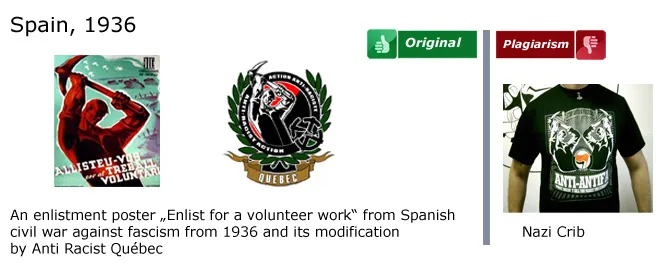
Kein Bock auf Nazis
is an antifascist campaign for schools and culture events.

Black Bloc
The tactic and the black dress - code (hood, shades, baseball cap, jacket) have been used by squatters, radical ecologists and antifascists since the 1970’s. Some neo-Nazis started to like this kind of image, but because the Autonomous Nationalists didn’t manage to find a presentable picture of their own, they didn’t hesitate to use a photo of an anarchist black bloc at the demonstration against G8 in Hamburg.
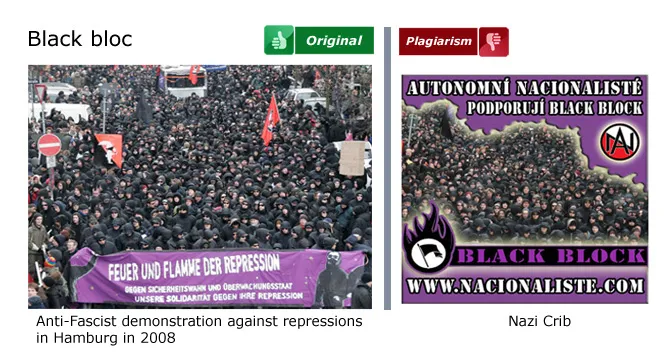

Straight Edge (sXe)
The idea of drug abstinence in the punk subculture appeared in late 1970’s in Washington D.C., when the local scene wanted to react to the growing aggression, mindless violence and destructive path that the punk movement had taken so far. Those who recognized this as a negative state of the scene decided to create a new lifestyle concept within the subculture and beyond. They stopped eating meat, disdained promiscuous sex, and refused to take drugs, smoke, or drink. The name Straight Edge (sXe) came from the eponymous song from Minor Threat. The lyrics were written by their singer, Ian McKaye. Ian made it clear both in his music and in his life that he is strictly against racist and neo-Nazi ideals. 20 years later, neo-Nazis discovered Straight Edge. Again, they are supporting a thought that emerged from punk subculture and which inherently opposes racism and neo-Nazism. One of the most appealing aspects for neo-Nazis, the explicit rejection of drugs, creates something of a caricature as traditional neo-Nazi practice includes heavy drinking and smoking as well as having contacts with the drug-dealing mafia and the practice of stuffing themselves with anabolic steroids. Straight Edge becomes yet another thing that doesn’t effect the real life of neo-Nazis - only the neo-Nazi merchandise. But it also remains a way to try to infiltrate certain subcultures.

Good Night White Pride (GNWP)
Neo-Nazis are also trying to infiltrate the hardcore subculture. The subculture has responded to these attempts with the Good Night White Pride campaign. So what is GNWP? It is the most widely known antifascist campaign that originally emerged from the punk and hardcore scene (where the motto “Hardcore is more than music” originated), but since its beginning, has reached out to other subcultures and genres and more and more bands and clubs are starting to support it.
The GNWP logo - the first of which was created in the 1990’s and was inspired by the notorious photo of an anti-racist activist dealing with a guy with a “celtic cross” on his t-shirt during an anti-racist demonstration in Montreal, Canada- appears on many of the hardcore (and other genres) flyers and clearly demonstrates that neo-Nazis are not welcome at these shows. Neo-Nazis can only dream about this kind of widespread support– and so they decided to profit from it by stealing the logo. How ironic – the photo that inspired the logo features an antifascist with dark skin causing pain to a neo-Nazi.

Let’s Fight White Pride (LFWP)
Is a follow-up to GNWP which originated in Germany. This campaign concentrates on building a scene that will be clearly defined as one against the neo-Nazis and racists who are attempting to infiltrate music genres and cultures. More info on
lfwp.de

Hatecore
When the Nazis realized that they couldn’t infiltrate the hardcore scene, they created Hatecore - the neo-Nazi version of hardcore music complete with Nazi lyrics. But, unsurprisingly, not even Hatecore is an original neo-Nazi idea. Hatecore, with its tough content and musical style, was established by the radical New York band SFA as social criticism of the social and political situation in the US in the 80’s. Hatecore wanted to express the anger and craving to change the situation.
Neo-Nazis stole the concept and, according to their ideology, they concentrated just on the “hate” part and added racist and discriminating lyrics. The racist/fascist point of view is backed up by merchandising and terms like “white power” and the stolen and modified slogan “Good Night Left Side”. An example of this is –
Good Night Left Side by Abolition, with lyrics.
The Nazi concept of hatecore even became a good business in the form of Hatecore-shop in Prague, which, until recently, was run by
Martin Franěk from National Resistance
. Nowadays the shop is located in Letňany and the official owner is Lada Hartmanová, the ex-girlfriend of two leading National Resistance activists, Jiří Tůma and Tomáš Kebza. The shop has gained notoriety through some of their t-shirt designs. One particularly ironic shirt is Anti-antifa shirt with a picture of a digging worker. Does it surprise anybody that this motif was originally on an enlistment poster, created to rouse antifascists to enroll as volunteers during the civil war against the fascist dictator Franco, who was heavily supported by Adolf Hitler himself?

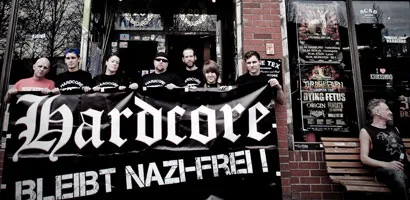
Animal Liberation Front (ALF)
ALF is a militant, protectionist, anarchist organization with affiliates all around the world. ALF saves animals from vivisection and mass breeding by many means -except attacking living beings. ALF stands against using animals as commodities. The intellectual basis of the organization lays in equality among all races and species, stating that the difference between animals and humans does not justify human superiority. ALF members must be surprised to see one of their best-known logos on the propaganda of Autonomous Nationalists - an organization built on inequality among people.

Autonom
There was an anarchist informational bulletin in the Czech Republic in the nineties called Autonom. This name was subsequently stolen by the web radio operator and police-rat Milan “Vydra” Šimeček.

Refugees welcome. Bring your family.
The motif of a family running away stating “Refugees welcome. Bring your family” was also stolen by Nazis and used in their own way.

Block Action
Another stolen motif is a figure from the logo of the Bloc Action cultural events organizers, a group that is setting up concerts for radical antifascists bands.

Demo disguises
The motif of two persons in balaclavas was created from a photo taken at an antifascist demonstration in Prague in 2003.

Disorder Berlin
The famous antifascist online shop didn’t escape the attention of neo-Nazi artists.

Subcomandante Marcos
The leading figure of the South Mexican emancipatory movement EZLN would be surprised if he saw how far his face got. Want to know more about
Marcos and EZLN
?

Food Not bombs
Zentropa members are not lazy and therefore didn’t hesitate to crib another FNB logo. Food Not Bombs is a form of positive protest against the billions spent for military, weapons and war in spite of the poverty of the masses. It is hard to imagine what Zentropa, with their neo-Nazi war fetish, will do with this logo.

Antifa Ultra
The antifa „ultra“ motif was stolen by neo-Nazis in czech city Kladno.

Skateboard and Bike
The neo-Nazi attempt to infiltrate the subculture of skaters and bikers is absurd and ridiculous. Neo-Nazi stickers and stencils are often decorated with people on bikes and boards attacking “multi-culti” people or antifascists. People from these subcultures have too often had a very different experience – that of neo-Nazis taking the space in the cities and towns from them, attacking them and destroying skate parks. As you can see on this video, active self-defense
can be more effective than words
.

Capitalism kills
Anti-capitalism is a new topic for neo-Nazis. For them, it doesn’t mean an end of the capitalist and hierarchized society. It means a struggle for power, the exploitation of animals, people and nature and a takeover of the current oppressors’ place.

A.F.A.B.
Few years ago, a collection of stickers with a skull and a motto “All fascists are bastards” appeared. An online NS shop from Brno took the chance and re-designed the stickers to state that antifascists are the bastards. How surprising.

Refugees Welcome

Conclusion?
The images above are pretty self-explanatory. Neo-Nazis are not simply bullies, stealing toys from other kids on the playground. They are loners, desperately trying to find out what toys are the others playing with so they can join them. Resistance is resistance only when it has both form and content. Let‘s leave the superficial cribs and plagiarisms to Nazis and let‘s build critical, political, autonomous and radical resistance in our streets, schools, towns, workplaces and regions. Don’t let nationalism tie us down; don’t let the state and the system control us and the races separate us. There is only one original.
Video Rechte Autonome